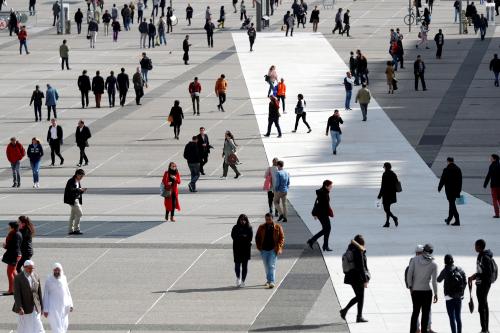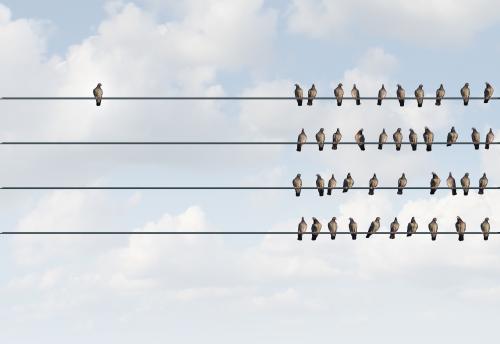A version of this op-ed was originally posted on Real Clear Policy on August 27, 2020.
The favored prefix of 2020 is “structural” — especially as applied to inequality and racism. The uneven impact of the COVID-19 pandemic and the killing of George Floyd have heightened awareness of the depths of our divides. Stark facts documenting the continued injustices faced by Black Americans have, in particular, become impossible for anybody of conscience to ignore.
The upsides of thinking structurally are clear: rather than highlighting specific choices made by particular individuals, the focus is correctly on the social, economic and political context in which they were made. There is a dangerous tendency to individualize structural problems, especially on the political Right.
Examining structural racism means considering the ways in which education systems, healthcare laws, and markets in housing, capital and labor all operate — and intersect — in ways that damage the lives of Black Americans. But there is a danger here too. Describing problems as structural or systemic can leave individuals feeling powerless to act. After all, if the problem is structural, what can one individual possibly do about it, except to proclaim the correct opinions?
Even more dangerously, the idea of structural problems can exonerate those who are personally responsible for creating the structures in the first place. Some affluent white liberals now use the right language and put the right signs in their front yard — but still oppose progressive reforms to zoning regulations or tax deductions or school assignment policies. Their activism is expressive: signs, tweets, posts, marches, petitions. Protests are highly general: against racism, for women.
For sure, these kinds of expressions are important in terms of changing the broader conversation. But the real work of tackling inequality takes place in what the philosopher Gerry Cohen labeled “the thick of daily life.” Egalitarianism is mundane, in the original sense of that word: in and of the world.
Treating equality as an everyday task starts with a hard look at our views on policy — especially where we stand to benefit. Taxes are a good case in point. In 2017, Donald Trump capped the value of the federal income tax deduction on state and local taxes, hitting affluent voters in blue states. Democratic leaders have vowed to reverse the policy. But it is hard to think of a more structurally racist or classist tax policy: Almost all the benefits of this $70 billion tax cut would go to the top 1% of households by income, 90% of whom are white.
But pursuing everyday equality also means attending to issues that are much closer to home. The housing market in many U.S. cities is rigged in favor of affluent white homeowners, largely as a result of restrictive local zoning requirements. But the opponents of fairer zoning are very often the same people lamenting inequality and segregation: The tightest zoning is in more liberal cities. Walking around my own rich, liberal suburban cocoon, I pass many signs declaring that “Hate Has No Home Here.” In my more cynical moments, I fantasize about putting up some new signs next to them: “But Restrictive Zoning Does!”
If you really want to tackle structural inequality, find out when your local housing board meets. Go. Organize and lobby for removing unfair zoning laws and building more affordable housing. Don’t fall for a bunch of claptrap about trees or parking. Join or form a local YIMBY (Yes in My Backyard) group to fight your neighborhood NIMBYs.
Everyday equality also means actively supporting measures to integrate public schools. This is something even liberal whites seem to find difficult. Witness the failed attempts in Democrat strongholds like Charlotte NC, Howard County MD and Seattle WA. Lobby your school PTA to give half of its money to a school with limited parental economic resources, given the way this kind of “para-funding” is increasing inequality between schools. Think of it as a form of “social offsetting,” if that helps. (The assumption here is that your children are in public school. It would be hard, after all, to vehemently oppose structural inequality while using your wealth to buy a better future for your kids by opting out into the private sector.)
What else? You should refuse to give any more money to your alma mater until they abolish the racist practice of legacy preferences. Better still, follow Metallica’s lead, and donate to a needier institution, such as the nearest community college. Pay anybody that works in your home a Living Wage. Only hire interns from disadvantaged backgrounds (rather than as a favor to a friend). Replace Take Our Daughters and Sons to Work Day with a community outreach program. Put your investments into a Black-owned bank.
In isolation, these seem like small beer. But in aggregate, millions of such decisions, investments and sacrifices would have huge effects. Structures of inequality don’t emerge out of thin air, and they won’t be simply waved away with a sweep of the right politician’s magic wand. They are embedded in our neighborhoods, our markets and our institutions — in each of which every single one of us plays a part, every single day. We cannot simply subcontract the promotion of fairness to the government.
The historian Richard Hofstadter argued that the Progressive Era was fueled by the self-criticism of the privileged. “The moral indignation of the age was by no means directed entirely against others,” he wrote in The Age of Reform. “It was in a great and critical measure directed inward. Contemporaries who spoke of the movement as an affair of the conscience were not mistaken.”
If your conscience has been stirred by the recent illumination of the structural barriers, good. But don’t just protest, or wait for better leaders. Start taking them down, right where you live, one brick at a time.







Commentary
Op-edEveryday equality
September 3, 2020